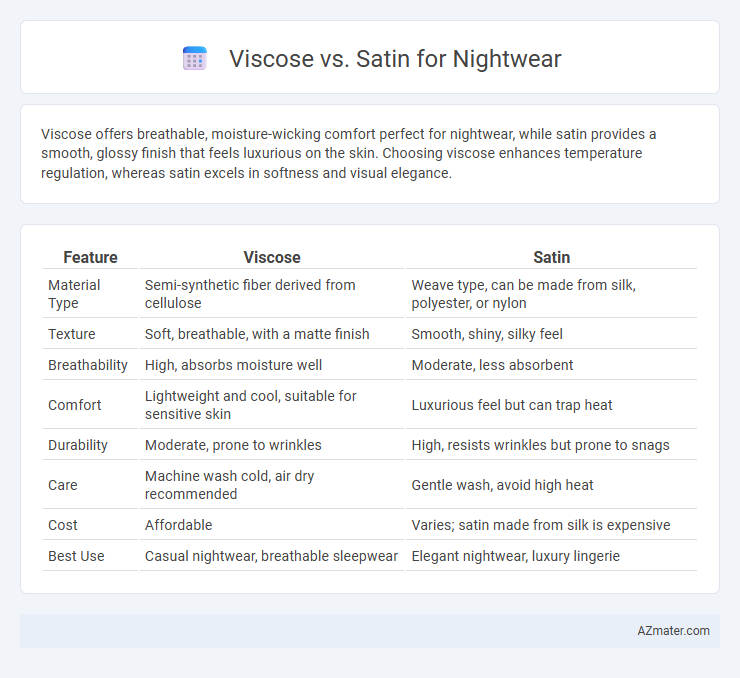Viscose offers breathable, moisture-wicking comfort perfect for nightwear, while satin provides a smooth, glossy finish that feels luxurious on the skin. Choosing viscose enhances temperature regulation, whereas satin excels in softness and visual elegance.
Table of Comparison
| Feature | Viscose | Satin |
|---|---|---|
| Material Type | Semi-synthetic fiber derived from cellulose | Weave type, can be made from silk, polyester, or nylon |
| Texture | Soft, breathable, with a matte finish | Smooth, shiny, silky feel |
| Breathability | High, absorbs moisture well | Moderate, less absorbent |
| Comfort | Lightweight and cool, suitable for sensitive skin | Luxurious feel but can trap heat |
| Durability | Moderate, prone to wrinkles | High, resists wrinkles but prone to snags |
| Care | Machine wash cold, air dry recommended | Gentle wash, avoid high heat |
| Cost | Affordable | Varies; satin made from silk is expensive |
| Best Use | Casual nightwear, breathable sleepwear | Elegant nightwear, luxury lingerie |
Understanding Viscose: Properties and Appeal
Viscose, a semi-synthetic fiber derived from natural cellulose, is prized for its silk-like softness, breathability, and moisture-wicking properties, making it ideal for comfortable nightwear. Its smooth texture and drapability enhance the sleeping experience by providing gentle warmth without overheating, suitable for various climates. The affordability and eco-friendliness of viscose, compared to synthetic fibers, add to its appeal for consumers seeking luxurious yet sustainable nightwear options.
Satin Explained: Texture, Composition, and Shine
Satin, a fabric characterized by its smooth and glossy surface, is typically woven from silk, polyester, or nylon fibers, creating a distinctive sheen that reflects light beautifully. Its unique weave produces a soft, luxurious texture that feels gentle against the skin, making satin an ideal choice for nightwear focused on comfort and elegance. The fabric's lustrous finish not only enhances aesthetic appeal but also contributes to its temperature-regulating properties, offering a cool sensation that is perfect for nightwear during warmer seasons.
Comfort Level: Viscose vs Satin for Nighttime Wear
Viscose offers superior breathability and moisture absorption, making it an ideal choice for comfortable nightwear, especially in warmer climates. Satin, typically made from polyester or silk, provides a smooth and luxurious feel but may trap heat and moisture, potentially causing discomfort during sleep. Selecting viscose nightwear enhances airflow and softness, promoting a cooler and more restful night's sleep compared to satin.
Breathability and Temperature Regulation
Viscose nightwear offers superior breathability due to its natural cellulose fibers, allowing better moisture absorption and enhancing comfort in warm conditions. Satin, often made from synthetic fibers like polyester, tends to trap heat and provides less effective temperature regulation, which can lead to night sweats. For optimal breathability and temperature control, viscose is the preferred fabric choice in nightwear.
Skin Sensitivity: Which Fabric is Gentler?
Viscose, derived from natural cellulose fibers, offers breathability and moisture absorption, making it highly suitable for sensitive skin prone to irritation. Satin, typically made from synthetic fibers like polyester, can sometimes trap heat and moisture, potentially causing discomfort for those with delicate skin. Viscose's silky smooth texture and hypoallergenic properties generally provide a gentler nightwear option compared to satin.
Durability and Care Requirements
Viscose nightwear offers moderate durability but requires gentle washing and air drying to maintain fabric integrity, as it is prone to shrinking and weakening when exposed to harsh detergents or high temperatures. Satin nightwear, often made from polyester or silk blends, provides higher durability with resistance to wrinkles and fading, but it demands delicate care such as hand washing or using a gentle cycle with cold water to preserve its smooth texture and sheen. Choosing between viscose and satin depends on balancing the preference for natural breathability against the desire for ease of maintenance and fabric longevity.
Style and Aesthetics: Visual Differences
Viscose nightwear offers a matte finish with a soft, natural drape that enhances a relaxed and casual aesthetic, while satin nightwear is characterized by its glossy, smooth surface that reflects light for a luxurious and elegant appearance. The textured weave of viscose creates subtle depth and warmth, contrasting with satin's sleek, mirror-like sheen that elevates nighttime glamour. Viscose tends to showcase muted, earthy tones effectively, whereas satin highlights vibrant colors and intricate prints with striking visual impact.
Price Comparison: Viscose vs Satin Nightwear
Viscose nightwear generally offers a more affordable price point compared to satin, making it a budget-friendly option without compromising on comfort. Satin nightwear, often made from silk or polyester blends, tends to be pricier due to its luxurious feel and glossy appearance. Consumers seeking cost-effective nightwear with a soft texture typically prefer viscose, while satin appeals to those willing to invest more for a sleek, elegant finish.
Eco-Friendliness and Sustainability Factors
Viscose, derived from natural cellulose fibers, offers biodegradability but often involves chemically intensive production processes that may impact environmental sustainability. Satin, typically made from synthetic fibers like polyester, has lower biodegradability and relies on petrochemical resources, raising concerns about long-term ecological effects. Choosing eco-friendly nightwear favors viscose with certified sustainable sourcing or organic alternatives, minimizing carbon footprint and water usage compared to conventional satin fabrics.
Choosing the Best Fabric for Your Nightwear Needs
Viscose offers breathability and moisture-wicking properties ideal for comfortable nightwear, while satin provides a smooth, luxurious feel that is gentle on the skin. Viscose is often preferred for its affordability and natural fiber blend, making it suitable for warmer climates or sensitive skin. Satin, typically made from silk or polyester, excels in aesthetic appeal and durability, perfect for those prioritizing style and elegance in their nightwear.

Infographic: Viscose vs Satin for Nightwear
 azmater.com
azmater.com